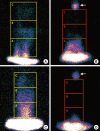The Vasodilator Effect of a Cream Containing 10% Menthol and 15% Methyl Salicylate on Random-Pattern Skin Flaps in Rats
- PMID: 26618115
- PMCID: PMC4659981
- DOI: 10.5999/aps.2015.42.6.695
The Vasodilator Effect of a Cream Containing 10% Menthol and 15% Methyl Salicylate on Random-Pattern Skin Flaps in Rats
Abstract
Background: It is still difficult to prevent partial or full-thickness flap necrosis. In this study, the effects of a cream containing menthol and methyl salicylate on the viability of randompattern skin flaps were studied.
Methods: Forty female Sprague-Dawley rats were divided into two equal groups. Caudally based dorsal random-pattern skin flaps were elevated, including the panniculus carnosus. In the study group, 1.5 mL of a cream containing menthol and methyl salicylate was applied to the skin of the flap, and saline solution (0.9%) was used in the control group. Upon completion of the experiment, flap necrosis was analyzed with imaging software and radionuclide scintigraphy. Histopathological measurements were made of the percentage of viable flaps, the number of vessels, and the width of the panniculus carnosus muscle.
Results: According to the photographic analysis, the mean viable flap surface area in the study group was larger than that in the control group (P=0.004). According to the scintigrams, no change in radioactivity uptake was seen in the study group (P>0.05). However, a significant decrease was observed in the control group (P=0.006). No statistically significant differences were observed between the groups in terms of the percentage of viable flaps, the number of vessels, or the width of the panniculus carnosus muscle (P>0.05).
Conclusions: Based on these results, it is certain that the cream did not reduce the viability of the flaps. Due to its vasodilatory effect, it can be used as a component of the dressing in reconstructive operations where skin perfusion is compromised.
Keywords: Menthol; Methyl salicylate; Perfusion; Surgical flaps; Vasodilator agents.
Conflict of interest statement
No potential conflict of interest relevant to this article was reported.
Figures








References
-
- Rinker B, Fink BF, Barry NG, et al. The effect of calcium channel blockers on smoking-induced skin flap necrosis. Plast Reconstr Surg. 2010;125:866–871. - PubMed
-
- Chen W, Yang D, Wang P, et al. Microencapsulated myoblasts transduced by the vascular endothelial growth factor (VEGF) gene for the ischemic skin flap. Aesthetic Plast Surg. 2011;35:326–332. - PubMed
-
- Miyawaki T, Jackson IT, Bier UC, et al. The effect of capsaicin ointment on skin for the survival of a cutaneous flap. Eur J Plast Surg. 2001;24:28–30.
-
- Pal S, Khazanchi RK, Moudgil K. An experimental study on the effect of nifedipine on ischaemic skin flap survival in rats. Br J Plast Surg. 1991;44:299–301. - PubMed
-
- Stadelmann WK, Hess DB, Robson MC, et al. Aprotinin in ischemia-reperfusion injury: flap survival and neutrophil response in a rat skin flap model. Microsurgery. 1998;18:354–361. - PubMed
LinkOut - more resources
Full Text Sources
Other Literature Sources

